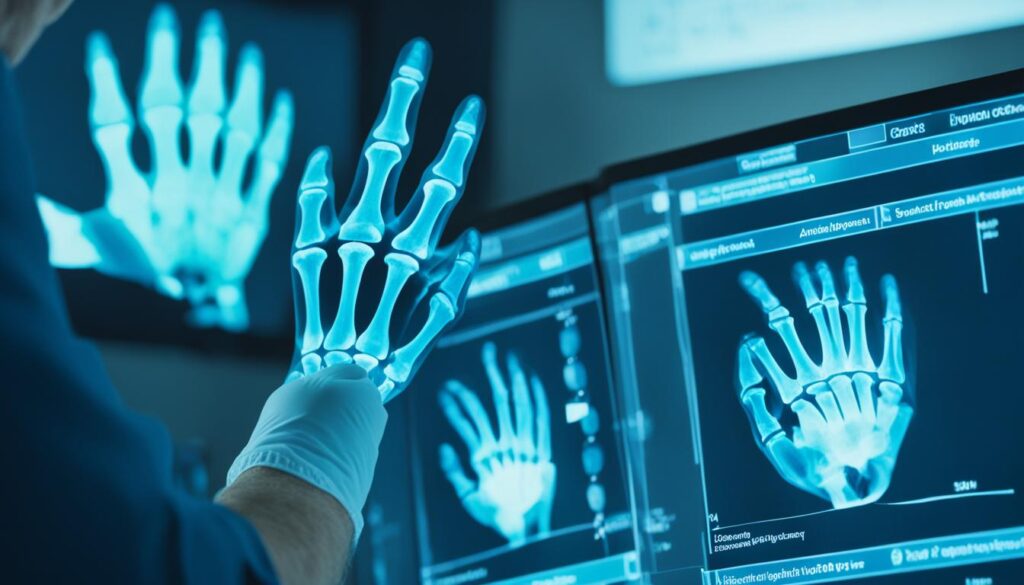Arthritis is a big reason for pain and disability across the globe. It can have a huge impact on daily life, making simple movements hard and affecting how you feel overall. Yet, there are ways to handle arthritis wisely and make your life better.
If you have osteoarthritis, rheumatoid arthritis, or any other kind, knowing how to deal is key. You can cut down on joint pain, move better, and take your life back by making lifestyle changes, adding exercise, and trying different treatments.
This guide brings you expert tips and advice on living with arthritis. We’ve teamed up with trusted institutions like the Mayo Clinic, Arthritis Foundation, and American Psychological Association. This makes sure our info is top-notch and reliable.
Here, you’ll find practical advice, science-backed strategies, and natural approaches. We cover everything from the basics to alternative medicine. This way, you have a lot of options to choose from that fit your needs and likes.
It doesn’t matter if you’ve just found out about your arthritis or have been dealing with it for a while. This guide is here to help you learn and use new tools. With what you find here, you can cut pain, move better, and boost your life’s quality.
Key Takeaways:
- Arthritis is a common condition that causes pain and disability worldwide.
- Managing arthritis effectively can help reduce joint pain and improve mobility.
- Lifestyle changes, exercise, medication management, and holistic therapies are key strategies for arthritis management.
- Consult with healthcare providers to create a personalized treatment plan tailored to your specific needs.
- By taking control of your arthritis, you can enhance your overall quality of life.
Understanding Arthritis Basics
Living with arthritis means knowing what kind you have and any joint damage. This helps you choose the right treatments for pain and care. Your doctor, family, and friends can help you understand and manage your arthritis.
Arthritis comes in different types, like osteoarthritis, rheumatoid arthritis, and psoriatic arthritis. Each one needs its own special way to manage pain. Knowing the details of your condition helps you meet your specific needs.
Arthritis often causes joint damage. If not managed, it can lead to worse conditions and less mobility. Actively taking care of your arthritis can slow down joint damage and make your life better.
“Understanding your arthritis type and the extent of joint damage is crucial in making appropriate treatment decisions.”
It’s important to keep an eye on your pain and tell your doctor about any changes. Talking openly with your healthcare team helps in adjusting your treatment when needed. They can suggest medicine, therapy, and life changes to help you feel better.
Pain management works best when you work together with your healthcare team and those supporting you. By making a plan together, you can lower pain, protect your joints, and feel good overall.
Types of Arthritis
| Type of Arthritis | Characteristics |
|---|---|
| Osteoarthritis | Causes cartilage breakdown and joint damage due to wear and tear |
| Rheumatoid Arthritis | Autoimmune disease that causes joint inflammation and damage |
| Psoriatic Arthritis | Linked to psoriasis, affects both skin and joints, leading to inflammation |
Lifestyle Changes for Arthritis Management
Managing arthritis pain well is about making some key lifestyle changes. You should focus on keeping your weight in check and quit smoking. Also, it’s important to include regular exercise and stretching in your daily life.
Weight Management
Keeping your weight down is very helpful for your joints. Losing weight slowly can relieve some arthritis pain. It takes the pressure off weight-bearing joints like the knees and hips.
Smoking Cessation
Smoking can actually make arthritis pain worse. It’s wise to stop smoking if you have arthritis. When you quit, you lower the inflammation in your joints and help your pain.
Exercise and Stretching
Exercise and stretching are vital for arthritis management. They boost your joint flexibility and muscle strength. Easy exercises like walking, swimming, or biking are good.
Yoga or tai chi can also make you more flexible and lessen pain. It’s important to enjoy the exercises you pick and that they suit your needs. A physical therapist can design an exercise plan just for you.
Always start with gentle exercises and slowly do more. Listen to your body’s limits and any pain it may feel. It’s all about being active without pushing too hard.
These lifestyle tweaks can really help with arthritis pain. They include managing your weight, quitting smoking, and sticking to exercise. By doing these, you might cut back on arthritis discomfort and have a better quality of life.
| Lifestyle Changes | Benefits |
|---|---|
| Weight Management | – Eases stress on joints – Lowers arthritis pain – Boosts how well you can move |
| Smoking Cessation | – Cuts inflammation – Lessens joint harm – Makes you feel better from arthritis |
| Exercise and Stretching | – Makes your joints move better – Boosts joint flexibility – Makes your muscles stronger – Helps with pain |

By changing your lifestyle in these ways, you can lead a better life with arthritis. Always talk to your doctor before making big changes or starting exercise.
“Making small changes in your everyday habits can have a big impact on managing arthritis pain and enjoying a more active lifestyle.” – Mayo Clinic Staff
Exercise Recommendations for Arthritis
Staying active is key for managing arthritis pain and keeping your joints healthy. Choose exercises that lessen pain, help flexibility, and build muscle. It’s vital to pick a mix of activities that fit your needs well. Here are some ideas to help you find the right exercises for your arthritis:
1. Low-Impact Exercises
Low-impact activities are great for those with arthritis. They don’t stress your joints too much, lowering the risk of injury. Walking, biking, and water exercises (like swimming) are top choices. They’re easy on your joints and boost your heart health.
2. Strength Training
Building muscle is crucial for joint support when you have arthritis. Gradual strength training with bands or weights can really help. It strengthens the muscles around your sore joints, making them more stable and easing pain.
3. Stretching and Range-of-Motion Exercises
Stretching can improve your joints’ flexibility and reduce stiffness. Add gentle stretches to your daily routine to feel better and move easier. Range-of-motion exercises also support your joint flexibility and lessen pain.
Start your exercises at a slow pace and then increase slowly. Always listen to your body and don’t push too hard, as this might make your arthritis worse. And remember, check with your doctor or a sports specialist first to make sure your plan is safe for you.
“Exercising regularly can do wonders for arthritis. It eases pain and stiffness, makes joints work better, and improves your life overall. Using a mix of low-impact workouts, strength training, and stretches can really change how you live with arthritis.”
Following a regular exercise plan and these tips for arthritis can better your joint health, lessen pain, and uplift your well-being. Stay focused on your workout, and adjust as you go along. Don’t forget to get advice from your doctor to tailor your exercise program for the best results.
Medication Options for Arthritis
In dealing with arthritis, many medication options are there for pain relief. These drugs can reduce pain, swelling, and improve how your joints work. For the best plan, talk with your doctor about what might work for you.
Commonly, people use over-the-counter pain meds for arthritis. These include acetaminophen, ibuprofen, and naproxen sodium. They’re good at lowering pain from physical activity. They make it easier to do your daily tasks with less pain.

But, it’s key to be smart about over-the-counter pain meds. If they’re not doing enough, or you need them all the time, see your doctor. They can suggest stronger meds or other treatments to ease your pain better.
Also, there are creams you can put on your skin for joint pain. Some creams use capsaicin, which is from hot peppers. These can help lessen pain for a little while. Just make sure to use them the way the label says and don’t use them on damaged skin.
Side Effects of Arthritis Medications
All medicines, including arthritis ones, can have side effects. Over-the-counter pain meds might cause upset stomach, heartburn, or make you dizzy. Make sure to take them right to lower your risk of side effects.
With capsaicin creams, you might feel a bit of burn or a tingle where you put them. But this usually goes away fast and is nothing to worry about. Keep an eye out for other problems. If they’re bad or they stick around, talk to your doctor right away.
| Pain Relief Medications | Topical Creams |
|---|---|
| Acetaminophen | Capsaicin |
| Ibuprofen | |
| Naproxen Sodium |
Always make sure to tell your doctor about how you’re feeling and what medicines you’re using. They’ll help you figure out the best way to control your pain. This way, you can lessen side effects and feel better.
Integrating Physical and Emotional Well-being
Arthritis pain is not only physical; it also affects our emotions. The mind-body link is crucial. So, it’s helpful to combine treatments for both parts to handle arthritis better.
Cognitive behavioral therapy (CBT) helps by changing how we think and act. It tackles negative patterns that increase pain and stress. People learn good ways to cope, manage stress, and solve problems. This can help them handle arthritis and feel better overall.
Relaxation therapy is great for easing pain and stress. Deep breathing, guided imagery, and muscle relaxation can make you feel calmer. These activities help control pain and lower stress when done regularly.
Acupuncture, a Chinese method, has become popular for easing arthritis pain. It uses thin needles in the skin to activate natural pain blockers. It makes the body produce endorphins, which are like natural painkillers. Those who try it often report less pain and better movement.
Heat and cold can also lessen arthritis pain. Heating sore joints boosts blood flow and cuts down pain. Cold therapy numbs the area, lowers swelling, and eases pain. They work well with other treatments to give temporary relief.
Massage can reduce arthritis symptoms too. It works the body’s soft tissues, relaxing muscles and improving blood flow. A good massage can target and relieve painful spots, easing movement and reducing discomfort.
Using these methods together can improve your quality of life with arthritis. But, always talk to your doctor to find what’s best for you. A balanced treatment plan, personalized to fit your needs, is key.
Diagnosis and Imaging for Arthritis
Finding out if someone has arthritis means looking for certain signs. Doctors check for swelling, redness, and warmth in the joints. They also use tests to see how bad the arthritis is and what type it might be.
Blood tests look for markers like rheumatoid factor and ESR. These markers can show how much inflammation is in your body. This helps diagnose arthritis types like rheumatoid arthritis.
Doctors may also check joint fluid. They insert a needle to take a small amount of fluid from the joint. Lab tests on this fluid can spot infections or inflammation. They are also good at finding disorders like gout.
Doctors often use images to see inside your joints, helping to spot problems. There are several types of imaging tests:
- X-rays: X-rays show bone damage and other issues, helping with osteoarthritis diagnosis.
- CT scans: These scans give detailed joint images, crucial for complex or early diagnosis.
- MRIs: MRIs show soft tissues, good for finding arthritis early and watching its progress.
- Ultrasounds: This tool makes pictures of the joints using sound waves. It’s great for seeing inflammation and swollen tissue.
These imaging tests help doctors know the full picture, from diagnosis to treatment success.

Table: Comparison of Imaging Tests for Arthritis Diagnosis
| Imaging Test | Advantages | Disadvantages |
|---|---|---|
| X-rays | Cost-effective, readily available, effective for diagnosing osteoarthritis | Cannot provide detailed images of soft tissues |
| CT scans | Precise assessment of bony structures, useful for complex joint evaluations | Exposure to ionizing radiation, higher cost compared to X-rays |
| MRIs | Excellent soft tissue visualization, helpful for early arthritis detection | Relatively expensive, restricted availability in some regions |
| Ultrasounds | Real-time imaging, ability to assess joint inflammation and fluid accumulation | Operator-dependent, limited penetration of certain tissues |
Using physical exams, blood tests, and images together helps doctors accurately diagnose arthritis. This allows for the best treatment planning and monitoring of the disease. Getting diagnosed early is crucial. It allows people to start managing their arthritis with support and the right interventions.
Treatment Options for Arthritis
The goal in treating arthritis is to make you feel better and help your joints work well. There are many ways to do this. Your treatment might include meds, physical therapy, or even surgery.
Medication Plans
Medicines are key in managing arthritis. They help with pain and lower swelling. Doctors often suggest these types of meds:
- Nonsteroidal anti-inflammatory drugs (NSAIDs) – These meds reduce pain and swelling.
- Counterirritants – These are creams or ointments that make your skin feel tingly, distracting from your joint pain.
- Steroids – They can be injected into your joint to quickly lower swelling and pain.
- Disease-modifying antirheumatic drugs (DMARDs) – Used in severe cases, they slow down the damage to your joints.
Physical Therapy
Physical therapy is vital for treating arthritis. It helps you move better and makes your joints stronger. A therapist will create exercises just for you. This can lessen pain and make it easier to move.
Surgery
If other treatments don’t help enough, surgery might be an option. The kind of surgery you need depends on your arthritis, where it is, and how bad it’s gotten. Common surgeries include:
| Surgical Procedure | Description |
|---|---|
| Joint Repair | It fixes parts of a joint, like cartilage, to help it work better. |
| Joint Replacement | It swaps out a damaged joint with a new, artificial one. |
| Joint Fusion | Fuses bones in a joint to stop pain and make it more stable. |
Surgery isn’t the first choice for most people. Doctors only suggest it after you’ve tried everything else. Always talk to an orthopedic surgeon before deciding on surgery.
Lifestyle and Home Remedies for Arthritis
Some lifestyle and home remedies can help you manage arthritis symptoms. Adding these to your day can lower pain and boost your life quality.
Weight Loss
It’s key to keep a healthy weight when dealing with arthritis, especially for joints that bear weight. Extra weight stresses the joints, causing more pain. A balanced diet helps you lose weight and stay healthy. You might want to talk to a dietitian for advice that fits you.
Exercise
Exercise is a must for arthritis. It keeps joints moving well. Choose activities like swimming, water aerobics, or biking. They work your heart without hurting your joints too much. Try to get 150 minutes of exercise each week.
Lifting weights also helps your muscles and joints. Use light weights at first. Make it harder slowly. Always warm up and cool down to stay safe.
Heat and Cold Therapy
Heat and cold can both ease arthritis pain for a bit. Use a heating pad or try a warm bath for stiff joints. Ice packs are good for swelling. Use both hot and cold, but keep a cloth between them and your skin. This prevents injuries.
Assistive Devices
Tools can make daily tasks less painful for arthritis. Look for tools that are easy on the joints, like jar openers. Braces or orthotics might help, too. An occupational therapist can suggest devices that fit your life.

| Exercise Benefits | Heat and Cold Therapy Benefits | Assistive Device Benefits |
|---|---|---|
|
|
|
To help with arthritis, try losing weight, exercising, using heat and cold, and using tools. Always consult your doctor for a plan that fits you best.
Alternative Medicine for Arthritis
Traditional methods help manage arthritis, but some people try alternative medicine. Things like acupuncture, glucosamine, and yoga are getting popular. People say these help lessen arthritis pain. But always check with your doctor first.
The Role of Acupuncture
Acupuncture is a Chinese therapy that uses thin needles to ease pain and help healing. Some arthritis patients find relief through acupuncture. It works by triggering the body’s healing mechanisms and reducing swelling. However, more research is needed to prove its effectiveness.
Exploring Glucosamine and Chondroitin
Glucosamine and chondroitin are supplements that some say help with arthritis pain. Glucosamine helps with cartilage repair, while chondroitin boosts its health. But, whether they offer real relief is still up for debate. Always ask your doctor before taking them, just to be safe.
The Benefits of Yoga
Yoga combines poses, meditation, and breath. It can boost flexibility, balance, and strength, easing arthritis symptoms. Plus, it’s good for reducing stress and enhancing your mood. Choose poses carefully and work with a qualified teacher for the best results.
Massage Therapy for Arthritis
Massage can relax muscles and ease arthritis discomfort. It helps with blood flow, lessens tension, and boosts joint movement. A skilled therapist can target inflamed joints and help relieve symptoms. Always make sure they have experience with arthritis patients.
Conclusion
Handling arthritis means using many strategies to deal with the condition. This includes changing how you live, staying active, overseeing your medicines, and using holistic methods. Doing this can make life better in big ways. It helps lessen pain, move better, and feel happier.
It’s very important to team up with your healthcare team to create a plan. This plan should meet your specific needs. Your healthcare team will guide you, keep track of how you’re doing, and make changes as needed.
There’s no single way to manage arthritis. It takes everyone, including you and your healthcare team, working together. With a full strategy in place, you can change how arthritis affects you. This will reduce your pain and help you have a better life.
FAQ
How can I manage arthritis effectively?
Managing arthritis well involves a few key steps. Learn about your arthritis type, its effects, and get help from your doctor and loved ones. Talk to your doctor often about your pain and keep an eye on any changes. Lifestyle changes, like losing weight and not smoking, can help too. Regular exercise and using certain medications also ease the symptoms.
What are some lifestyle changes that can help with arthritis pain relief?
Changing your lifestyle can really help lessen arthritis pain. Losing weight slowly takes pressure off your joints. Stopping smoking can also lower your pain. It’s good to exercise and stretch to keep your joints moving. This strengthens your muscles and helps with pain too.
What exercises are recommended for managing arthritis pain?
Exercise is key for controlling arthritis pain. Go for low-impact activities like walking, biking, or in water. These help reduce pain, increase motion, build muscle, and boost stamina. Doing regular stretches, movement exercises, and gently getting stronger also helps a lot.
What medication options are available for arthritis pain relief?
There are many medications to ease arthritis pain. You can try over-the-counter options like acetaminophen or ibuprofen. Creams with capsaicin can be good for applying on sore joints. If these don’t help much, see your doctor for other options.
How can I manage the emotional aspect of arthritis?
Dealing with arthritis is also about taking care of your mind. Cognitive therapy and relaxation techniques can stop pain cycles in your brain. Heat, cold packs, and massages help ease pain and mood. They’re simple ways to feel better emotionally.
How is arthritis diagnosed?
Diagnosing arthritis starts with a physical exam. This checks for joint issues and swelling. Blood tests and joint fluid checks tell what type of arthritis it is. Images like X-rays show any joint damage.
What are the treatment options for arthritis?
Arthritis treatments aim to reduce pain and improve joint use. Doctors might suggest medicines, physical therapy, or even surgery. The right treatment plan depends on the arthritis type and how severe it is.
Are there any lifestyle and home remedies for managing arthritis?
There are lifestyle changes and home care steps that help with arthritis. Losing weight eases the strain on joints. Gentle exercises like swimming keep your joints moving. Hot and cold treatments can quickly relieve pain. Using tools that make daily tasks easier is also useful.
Can alternative medicine help with arthritis symptoms?
Alternative treatments like acupuncture and yoga might reduce arthritis pain. But, their effects vary for each person. Always talk to your doctor before starting any new treatment to make sure it’s safe and right for you.
What should be my approach to managing arthritis?
To manage arthritis, try a mix of lifestyle changes, exercise, and therapy, along with any needed medicines. Each person’s plan is different, so working with your healthcare team is vital. This approach can help ease your pain and make life better.




















